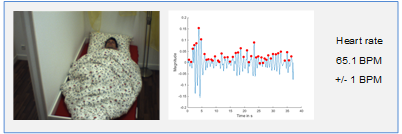Internationale Partnersuche
Innovation & Technologie Angebot
Contactless method to determine heart rate
Country of Origin: Germany
Reference Number: TODE20190207002
Publication Date: 7 February 2019
Summary
A German inventor specialised in the field of signal and image processing has developed a method to determine heart rate without physical contact by means of a camera. This opens up the possibility to evaluate this vital parameter in an unobtrusive way. Possible target fields are elderly care, automotive, e-rehabilitation or marketing studies. Partners are sought for research agreement and license agreements in the single application fields.
Description
Specialised in the field of signal and image processing, a German scientist at a technical university has developed a method to determine heart rate without physical contact by means of a camera.
Currently, for the determination of vital parameters, such as the heart rate, conventional methods such as the ECG (electrocardiography) are used. However, these conventional methods have the disadvantage that they use body worn systems, which are uncomfortable for their wearer over longer measurement periods or in some cases not a viable means of measurement.
Therefore, a technology has been developed that allows contactless heart rate measurement via optical sensors, such as a camera. The light intensity or colour of the skin is very precisely determined and analysed over time. The core innovations are an individual, scene-specific skin colour model as well as accurate tracking based on the optical flow. This is accompanied by signal processing methods such as an independent component analysis and adaptive filtering.
As a result, the heart rate can be detected robustly in various application scenarios and accurately determined, even if the person is in motion.
There are many fields of application for the contactless measurement of heart rates:
--> In the field of ambient assisted living, such a solution can enable more precise measurement of the heart rate of elderly persons in their familiar environment. No additional devices must be worn and therefore cannot be misplaced or neglected to be worn, i.e. in case of dementia
--> In E-rehabilitation, the training status can be monitored in real time and give instant feedback on training intensity.
--> Furthermore, marketing research represents another field of application. The physiological reactions of test subjects can be analysed inconspicuously.
--> The danger of sudden infant death can be reduced by a contactless monitoring system placed above the child's bed.
--> By monitoring a vehicle driver’s vital parameters events such as fatigue, emotional stress and health problems can be identified. Critical situations can be recognised to pre-emptively prevent accidents.
--> It is also possible to use the technology for triage in hospitals, for health safety in public spaces and in special situations in the event of a disaster.
Cooperation with companies that evaluate vital data in real time are primarily envisioned as potential partners who would apply the invention in the most diverse fields and use it as a basis for further implementations. Partners of all company sizes are sought for research and license agreements for product developments in any of the aforementioned or other application fields. Possible cooperation types are license agreements and research and research cooperation agreements. In a first step, this technology can be adjusted for a certain target application field in cooperation between the partners. For a resulting product licenses can be obtained.

Advantages and Innovations
Conventional methods such as the use of an ECG or pulse oximeter require physical contact with the body. This can be a problem for people with sensitive skin such as elderly persons, new-borns or burn victims. In addition, the comfort for the individual person increases noticeably.
In contrast to other contactless methods of heart rate determination, the elimination of intensity and movement artefacts is the focus of the presented method. This enables robust measurements in challenging situations where the person is not able to remain stationary.
On the basis of a test person study it could be proved that the Root-Mean-Squared-Error remained below 3 beats per minute even during demanding test situations.
Stage Of Development
Under development/lab tested
Requested partner
The invention is aimed at companies that evaluate vital data in real time in the most diverse fields of application and use it as a basis for further action decisions. Companies that process vital data from the user's point of view are also addressed.
Cooperation offer ist closed for requests

